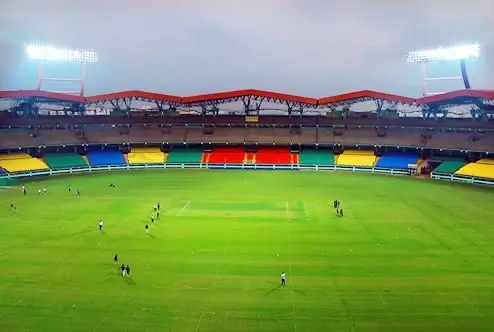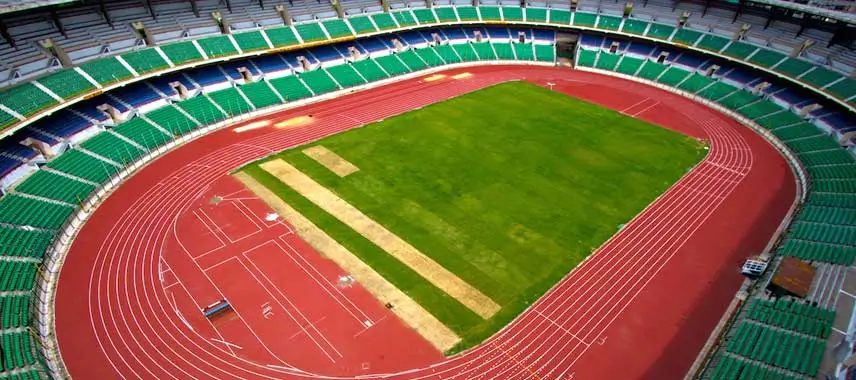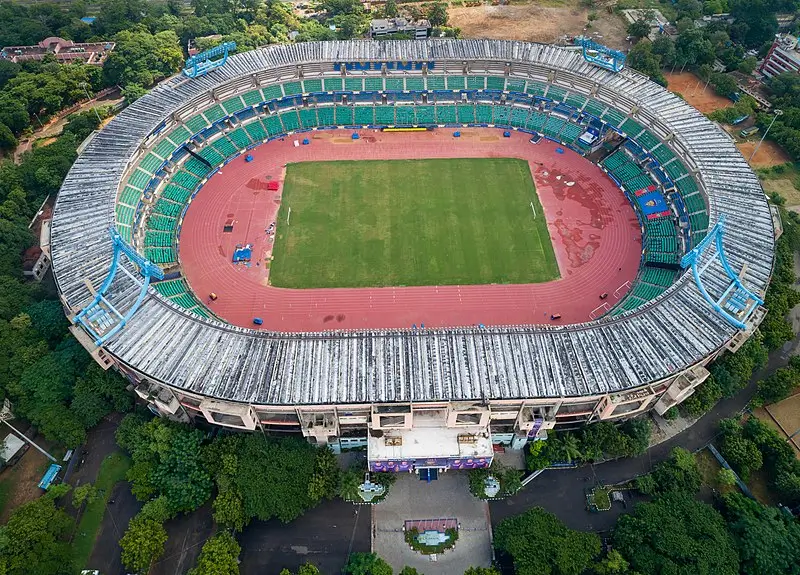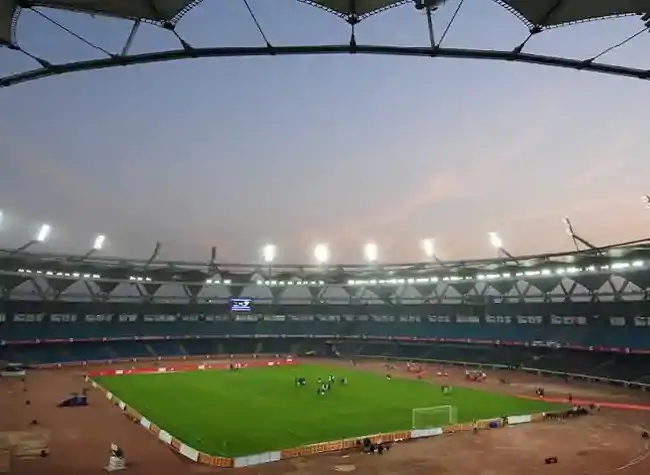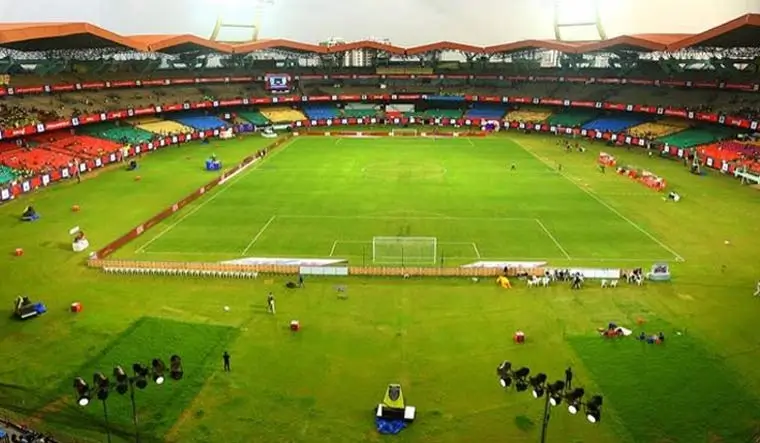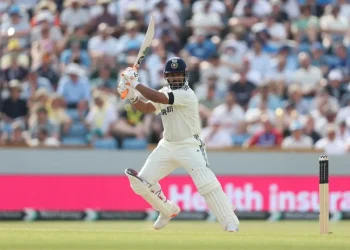Jawaharlal Nehru Stadium in New Delhi, named after India’s first Prime Minister, is a monumental multi-sport venue with a rich history. Constructed for the 1982 Asian Games, it has a capacity of about 60,000, making it one of the largest stadiums in India. Known for its distinctive cantilever roof, the stadium has undergone significant modernizations, including renovations for the 2010 Commonwealth Games.
Over the years, Jawaharlal Nehru Stadium has been the site for significant events beyond sports, including cultural and political rallies. It underwent extensive renovations for the 2010 Commonwealth Games, which upgraded its facilities and athletics track.
Today, it regularly hosts football matches, including being the home ground for the Indian Super League’s Delhi Dynamos FC, and occasionally, it serves as a venue for cricket matches and large-scale concerts. The stadium’s adaptability and historical significance make it central to New Delhi’s sporting and cultural landscape.
It hosts football matches and athletics and is a favored site for major cultural and political events. As the home ground for the Indian Super League’s Delhi Dynamos FC and a venue for international music concerts, Jawaharlal Nehru Stadium symbolizes the dynamic intersection of sports, culture, and community in India’s capital.
Jawaharlal Nehru Stadium in New Delhi is a versatile and iconic sports venue renowned for hosting various national and international events. Named after India’s first Prime Minister, it was constructed to host the 1982 Asian Games. The stadium boasts a seating capacity of approximately 60,000, making it one of the largest stadiums in India. Its distinctive architectural feature is the cantilever roof, a unique element at the time of its construction.
Jawaharlal Nehru Stadium: A Landmark of Sports and Culture in New Delhi
The Jawaharlal Nehru Stadium, located in the heart of New Delhi, India, is one of the country’s most iconic and versatile sports complexes, like Mullanpur Stadium in Mohali, Punjab. Named after India’s first Prime Minister, Jawaharlal Nehru, this stadium symbolizes India’s sporting aspirations and is a hub for cultural and entertainment events. With a rich history and state-of-the-art facilities, the stadium has hosted numerous national and international events, making it a cornerstone of India’s sporting infrastructure.
History and Development
The Jawaharlal Nehru Stadium was initially constructed in 1982 to host the Asian Games, a major multi-sport event in New Delhi. The stadium was designed by a team of architects led by Raj Rewal and structural engineer Mahendra Raj. Inspired by the lotus flower, its unique circular design reflects a blend of modernity and Indian cultural symbolism.
In 2010, the stadium underwent a massive renovation to prepare for the Commonwealth Games. The renovation included upgrading seating capacity, improving infrastructure, and adding advanced facilities to meet international standards. Today, the stadium is a world-class venue capable of hosting various events, from athletics and football to concerts and cultural festivals.
Architecture and Capacity
The stadium’s architecture is a marvel of engineering and design. Its circular structure ensures unobstructed views from every seat, creating an immersive experience for spectators. The roof, made of a lightweight tensile membrane, covers the entire seating area, providing shade and protection from the elements.
With a seating capacity of approximately 60,000, the Jawaharlal Nehru Stadium is one of the largest stadiums in India. The seating arrangement is divided into multiple tiers, offering excellent visibility from all angles. The stadium also features VIP boxes, media centers, and dedicated areas for athletes and officials.
Athletics Track
The Jawaharlal Nehru Stadium features an eight-lane synthetic athletics track. This track meets international standards, ensuring high-quality performance for athletes. It is designed for various track and field events, including sprints and long-distance races. The synthetic surface provides excellent grip and reduces the risk of injuries. Athletes from across the globe have competed on this prestigious track. The stadium has hosted national and international athletics championships over the years.
Its world-class facilities make it a preferred venue for major sporting events like Nassau County Stadium. The track is regularly maintained to ensure optimal conditions for competitions. It serves as a training ground for aspiring Indian athletes. The stadium’s athletics track symbolizes India’s commitment to promoting sports excellence.
Football Pitch
The stadium boasts a FIFA-approved football pitch, meeting global sports standards. This pitch has hosted numerous domestic and international football matches. It features high-quality turf, ensuring smooth gameplay and player safety. The pitch is designed to withstand heavy usage during tournaments. It has witnessed thrilling matches involving top Indian and international football teams.
The stadium’s football facilities are regularly upgraded to maintain global standards. It serves as a key venue for major football events in India. Professional clubs also use the pitch for training sessions. Its central location makes it accessible to players and fans alike. The football pitch is a testament to India’s growing football culture.
Training Areas
The stadium includes dedicated training facilities for athletes to enhance their skills such HPCA Stadium. These areas feature warm-up tracks and practice fields for various sports. Athletes can prepare for competitions in a professional and supportive environment. The training zones are equipped with modern equipment and amenities. They cater to both individual athletes and teams across disciplines.
The facilities are designed to simulate actual competition conditions for better preparation. Coaches and trainers have access to these areas for guided sessions. The training grounds are regularly maintained to ensure safety and quality. They play a crucial role in nurturing India’s sporting talent. These areas highlight the stadium’s commitment to athlete development and performance.
Floodlights
The stadium is equipped with high-intensity floodlights for evening and night events. These lights ensure optimal visibility for both players and spectators. They meet international standards for hosting night-time sports competitions. The floodlights are energy-efficient and provide uniform illumination across the stadium. They enable the venue to host events beyond daylight hours, such as at Barsapara Stadium of Guwahati.
Concerts and cultural programs also benefit from this advanced lighting system. The floodlights enhance the overall experience for attendees during evening events. They are regularly maintained to ensure consistent performance. The lighting system reflects the stadium’s modern infrastructure and versatility. It allows the venue to maximize its usage throughout the day and night.
Accessibility
The stadium is designed to be fully accessible for people with disabilities. It features ramps, elevators, and designated seating areas for differently-abled visitors. These facilities ensure inclusivity and comfort for all attendees. The venue complies with international accessibility standards for public spaces.
Wheelchair users can navigate the stadium easily with ramps like Talkataora Stadium of Delhi. Elevators provide access to different levels of the seating areas. Dedicated staff are available to assist visitors with special needs. The stadium’s design reflects a commitment to equality and inclusivity. It has set an example for other venues in India. The accessibility features make it a welcoming space for everyone.
Parking and Connectivity
The stadium offers ample parking space for vehicles, accommodating thousands of visitors. It is well-connected to public transportation, including the Delhi Metro. The nearby JLN Metro Station ensures easy access for spectators and participants. The parking facilities are designed to handle large crowds during significant events. Clear signage and efficient management streamline the parking process.
The stadium’s central location in New Delhi enhances its accessibility. It is easily reachable from various parts of the city and beyond. The connectivity options reduce traffic congestion during events. The parking and transportation facilities contribute to a hassle-free experience. They make the stadium a convenient venue for both local and international visitors.
Parking Facilities at Jawaharlal Nehru Stadium
Parking Charges
| Vehicle Type | Parking Fee (Approx.) | Notes |
|---|---|---|
| Two-Wheelers | ₹20 – ₹50 | Rates vary for regular vs. event days. |
| Cars/SUVs | ₹100 – ₹300 | Higher fees during major matches/concerts. |
| VIP/Corporate Vehicles | ₹500 – ₹1,000 | Dedicated parking near stadium gates. |
Key Parking Facilities
- Proximity: Parking zones are within 500 meters of stadium entrances.
- Security: Guards patrol lots but avoid leaving valuables in vehicles.
- Disabled Parking: Reserved slots near gates for easy access.
- Event-Day Shuttles: Free shuttle services from outer parking areas.
- Pre-Booking: Limited slots are available online for high-demand events.
Important Notes
- Parking fills up quickly during ISL matches or concerts.
- Charges may rise by 50–100% for playoffs or celebrity events.
- Use public transport (buses, metro) to avoid parking hassles.
- Confirm rates via the stadium’s official website before arrival.
Major Events Hosted at the Jawaharlal Nehru Stadium
Over the years, the Jawaharlal Nehru Stadium has been the venue for several high-profile events, including:
- 1982 Asian Games: The stadium’s inaugural event marked India’s emergence as a host for international sporting events.
- 2010 Commonwealth Games: The stadium was the main venue for the opening and closing ceremonies and athletics events.
- AFC Asian Cup 2011: The stadium hosted several matches during the prestigious football tournament.
- Concerts and Cultural Events: Apart from sports, the stadium has hosted concerts by international artists like Bryan Adams, Metallica, and Justin Bieber, as well as cultural festivals and exhibitions.
How do you book tickets for Jawaharlal Nehru Stadium?
- Online Booking Platforms
Purchase tickets via BookMyShow, Paytm Insider, or official event websites. Secure seats early for high-demand matches or concerts.
- Offline Ticket Counters
Visit the stadium box office days before the event. Carry valid ID proof for seamless offline transactions. - Corporate and Group Reservations
Contact stadium management for bulk or VIP bookings. Custom packages are available for corporate events or large groups. - Discounts and Early Bird Offers
Check platforms for student, family, or group discounts. Early bird tickets provide cost-effective access to premium seats.
Steps to Ensure a Smooth Booking Experience
- Verify Event Dates: Confirm schedules on official websites.
- Compare Prices: Review seating categories and pricing tiers.
- Check Payment Options: Use UPI, cards, or net banking securely.
- Download E-Tickets: Save digital tickets to avoid last-minute issues.
Important Reminders
- Avoid third-party sellers to prevent scams or fake tickets.
- Review stadium rules (e.g., prohibited items) before purchasing.
Ticket Price Structure at Jawaharlal Nehru Stadium
1. Football Matches (Indian Super League – ISL)
| Category | Price Range (₹) |
|---|---|
| General Stands | 300 – 800 |
| Premium Pavilion | 1,000 – 1,500 |
| Corporate Boxes | 3,000 – 5,000 |
2. Cricket Matches (ODIs, T20Is)
| Category | Price Range (₹) |
|---|---|
| General Stands | 500 – 2,000 |
| Premium Pavilion | 2,500 – 5,000 |
| Corporate Boxes | 10,000 – 20,000 |
3. Concerts & Cultural Events
| Category | Price Range (₹) |
|---|---|
| Standing Zones | 500 – 2,000 |
| Seating Zones | 2,000 – 8,000 |
| VIP Sections | 10,000+ |
4. Discounts & Special Offers
| Category | Discount Details |
|---|---|
| Students | 10–20% off with valid ID |
| Family Packages | Group discounts for 4+ members |
| Early Bird Tickets | 15–25% off if booked in advance |
Key Notes
- Prices vary based on event popularity, teams, or performers.
- Corporate boxes include perks like catering and exclusive access.
- Check official websites for real-time updates and promotions.
Role in Indian Sports
The Jawaharlal Nehru Stadium has been pivotal in promoting sports in India. It has been a training ground for many Indian athletes who have succeeded globally. National and state-level athletes regularly use the stadium’s facilities for training and competitions.
Moreover, the stadium has been instrumental in fostering a sports culture among the youth. It has hosted numerous school and college-level tournaments, inspiring the next generation of athletes.
Nurturing Champions on the Global Stage
The Jawaharlal Nehru Stadium has shaped India’s sporting legacy by training elite athletes. Its world-class facilities attract national and state-level competitors for rigorous preparation. Many athletes honed here have won medals at Asian Games and Commonwealth events. The stadium hosts national championships, fostering healthy competition among emerging talents.
It provides access to advanced equipment and expert coaching for skill development. Regular upgrades ensure alignment with global sporting standards. The venue’s role extends beyond competitions to grassroots talent identification programs. Bridging gaps in infrastructure empowers athletes to excel internationally. This iconic stadium remains a cornerstone of India’s sports ecosystem.
Inspiring Youth Engagement in Athletics
The stadium actively promotes sports culture among India’s youth through school tournaments. Inter-college events held here ignite a passion for athletics and teamwork in students. It offers subsidized training programs to nurture underprivileged talents across disciplines. Workshops with Olympians and coaches motivate young athletes to pursue sports professionally.
The venue’s accessibility encourages schools to organize annual sports festivals here. Creating role models inspires the next generation to embrace active lifestyles. Youth leagues hosted at the stadium build discipline and leadership skills. Its inclusive environment breaks barriers for female athletes in traditionally male-dominated sports. This focus on youth ensures a sustainable pipeline of future champions.
Future Prospects
As India grows as a global sporting powerhouse, the Jawaharlal Nehru Stadium is expected to play an even more significant role. Plans are underway to upgrade its facilities and make it a sustainable venue. The stadium is also considered a potential host for future international events, including the Olympics.
Infrastructure Modernization and Sustainability Goals
Plans are underway to transform the stadium into a green, tech-driven venue. Solar panels and rainwater harvesting systems will reduce its environmental footprint. Renovations aim to expand seating capacity and enhance spectator comfort. Cutting-edge LED lighting and digital scoreboards will elevate the viewing experience. The stadium may integrate virtual reality for immersive fan engagement during events.
Partnerships with private firms will ensure world-class maintenance and operational efficiency. Sustainable materials will be prioritized in future construction projects. These upgrades align with India’s vision of hosting mega-events like the Olympics. The focus remains on balancing modernization with heritage preservation.
Olympic Aspirations and Global Recognition
The stadium is a strong contender for hosting Olympic events in future bids. Its existing infrastructure meets IOC standards for athletics and football competitions. Government initiatives aim to position it as Asia’s premier multi-sport hub. Successful Commonwealth Games 2010 operations bolster its credibility for more significant events. International federations recognize its potential to organize World Championships.
Legacy-building projects will enhance its appeal to global sporting bodies. Hosting the Olympics could accelerate India’s rise as a sporting superpower. The stadium’s strategic location and connectivity further strengthen its candidacy. Such ambitions highlight India’s growing influence in the global sports arena.
Versatility Beyond Sports: Cultural and Social Impact
The stadium transcends sports by hosting concerts, exhibitions, and political rallies. Global artists like Metallica have performed here, attracting diverse audiences. It serves as a melting pot for cultural exchange and artistic innovation. Social initiatives, such as vaccination drives, utilize its vast space during crises. The venue’s adaptability is a vital asset for Delhi’s civic life.
Accommodating diverse events strengthens community bonds and democratic values. Its role in shaping India’s soft power cannot be overstated. The stadium is not just a structure but a living, breathing symbol of progress. It promises to remain relevant for generations through constant reinvention.
Best Ways to Reach Jawaharlal Nehru Stadium
1. Delhi Metro (Violet Line)
The Violet Line’s Jawaharlal Nehru Stadium Metro Station offers direct stadium access. Follow exit signs to reach the venue within minutes. Trains run frequently, making this the fastest and most eco-friendly option. Avoid peak hours for a hassle-free commute.
2. Public Buses (DTC Routes)
Multiple DTC buses stop near Lodhi Road or Bhishma Pitamah Marg. Alight at these stops and walk 10–15 minutes to the stadium. Check route maps for buses like 438, 521, or 540. Affordable but slower due to traffic congestion.
3. Taxi or Ride-Hailing Apps
Book cabs via Ola/Uber for door-to-door convenience. Enter “Jawaharlal Nehru Stadium, Pragati Vihar” as your destination. It is ideal for groups or travelers with heavy luggage. Ride costs vary based on demand and distance.
4. Private Vehicles
Drive via Ring Road or Bhairon Marg, using GPS navigation. Limited parking is available near Gates 1 and 10. Arrive early during events to secure parking slots. Expect delays on match days or concert nights.
5. Walking or Cycling
Walking is feasible from nearby areas like Pragati Vihar or CGO Complex. Use shaded pathways for comfort in Delhi’s heat. Cycle racks are available near entry gates for short-distance riders.
Pro Tips
- Monitor traffic via Google Maps/WhatsApp alerts before leaving.
- Metro services extend post-midnight during significant events.
- Share autos ply between nearby hubs and the stadium.
Nearest Landmarks to Jawaharlal Nehru Stadium
Historical Marvels
- Humayun’s Tomb (2 km)
A UNESCO World Heritage Site showcasing Mughal architecture and lush gardens. Its grandeur attracts history buffs and photographers alike. - Safdarjung Tomb (2 km)
An 18th-century mausoleum with intricate carvings and serene surroundings. It reflects late Mughal design influences. - Lodhi Garden (1.9 km)
Spanning 90 acres, it blends historical tombs with landscaped greenery. Ideal for jogging, picnics, or exploring medieval monuments.
Cultural & Recreational Spaces
- India Habitat Centre (1.6 km)
A hub for art exhibitions, conferences, and cultural festivals. Features cafes, galleries, and performance venues. - Sunder Nursery (1.4 km)
A 16th-century heritage park with Mughal-era monuments and biodiverse plantations. Perfect for nature walks and history tours. - Dargah Hazrat Nizamuddin Auliya (2.4 km)
A revered Sufi shrine hosting soulful qawwali sessions. A spiritual retreat amid Delhi’s chaos.
Shopping & Community Hubs
- Khan Market (2 km)
Delhi’s upscale market offers global cuisine, boutiques, and bookstores. A favorite among locals and tourists. - Pragati Maidan (3 km)
An exhibition center hosting trade fairs, cultural events, and conventions. Connects modernity with India’s industrial growth.
Near the stadium, these sites offer a mix of history, culture, and leisure. Explore Mughal legacies, unwind in green spaces or savor urban delights—all within a short commute. Perfect for pre-event exploration or post-event relaxation.
Conclusion
The Jawaharlal Nehru Stadium embodies India’s journey from its colonial past to sporting modernity. Its architecture merges cultural symbolism with cutting-edge engineering brilliance. The venue has witnessed historic moments that united millions in celebration. Beyond sports, it reflects India’s ability to organize world-class events independently.
Its legacy is intertwined with the nation’s post-independence identity and progress. The stadium stands as proof of India’s resilience and ambition. It continues to inspire citizens to dream bigger and achieve excellence. Every event here reinforces national unity and pride. This iconic structure remains etched in India’s collective memory.
The Jawaharlal Nehru Stadium is more than just a sports venue; it symbolizes India’s aspirations and achievements in sports and culture. With its world-class facilities, rich history, and central location, the stadium continues to be a beacon of excellence and pride for the nation. Whether it’s a thrilling football match, a high-octane athletics event, or a mesmerizing concert, the Jawaharlal Nehru Stadium offers an unforgettable experience for all who visit.


